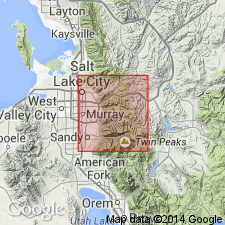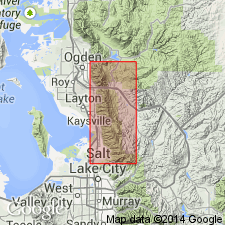
- Usage in publication:
-
- Little Willow series*
- Modifications:
-
- Named
- Dominant lithology:
-
- Quartzite
- Schist
- AAPG geologic province:
-
- Southern Rocky Mountain region
Summary:
Named probably [though not specifically stated] for exposures in Little Willow Creek, just north of Little Cottonwood Canyon, Salt Lake Co, UT in Southern Rocky Mountain region. No type locality designated. Is a sequence of strongly folded gneissic quartzites, quartz-mica schists, and stretched-pebble schists intruded by basic igneous rocks that have been altered to amphibolite and chlorite-amphibole schist. Crops out in Little Willow Creek. Is the oldest rock exposed in the core of the Uinta arch. May be equivalent to Farmington Canyon complex. Is of pre-Cambrian age. Geologic map.
Source: GNU records (USGS DDS-6; Denver GNULEX).

- Usage in publication:
-
- Little Willow Formation*
- Modifications:
-
- Age modified
- AAPG geologic province:
-
- Southern Rocky Mountain region
Summary:
Compositionally resembles and is a correlative of Farmington Canyon Complex. Lacks distinctive rock types of the Facer Formation. Thermal overprint from nearby Little Cottonwood stock makes exact age determination difficult. Lies south of margin of Archean continent, Salt Lake Co, UT in the Southern Rocky Mountain region. Assigned to Early Proterozoic (previously assigned to early Precambrian and to Middle Proterozoic).
Source: GNU records (USGS DDS-6; Denver GNULEX).
For more information, please contact Nancy Stamm, Geologic Names Committee Secretary.
Asterisk (*) indicates published by U.S. Geological Survey authors.
"No current usage" (†) implies that a name has been abandoned or has fallen into disuse. Former usage and, if known, replacement name given in parentheses ( ).
Slash (/) indicates name conflicts with nomenclatural guidelines (CSN, 1933; ACSN, 1961, 1970; NACSN, 1983, 2005, 2021). May be explained within brackets ([ ]).

